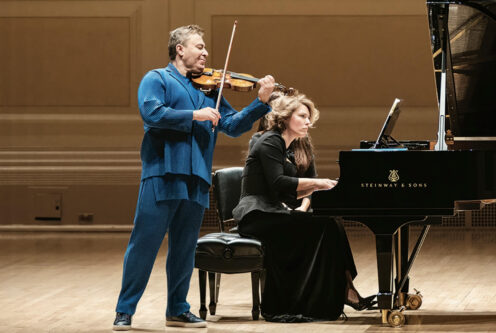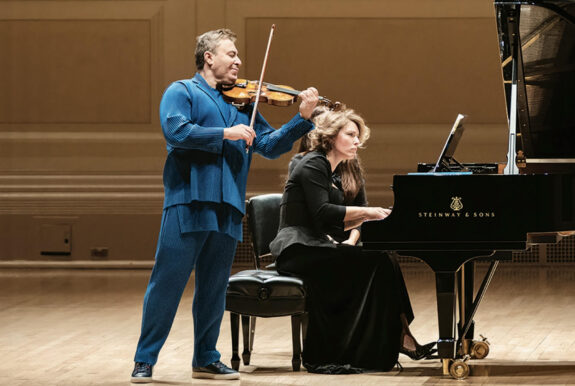 United States Various: Maxim Vengerov (violin), Polina Osetinskaya (piano). Cal Performances, Zellerbach Hall, University of California, Berkeley, 23.11.2024. (HS)
United States Various: Maxim Vengerov (violin), Polina Osetinskaya (piano). Cal Performances, Zellerbach Hall, University of California, Berkeley, 23.11.2024. (HS)

Prokofiev – Five Melodies, Op.35; Violin Sonata No.2 in D major, Op.94a
Franck – Sonata in A major for Violin and Piano
Ravel – Tzigane
Maxim Vengerov is a generational talent, a violinist with a restless mind, appreciable technique and the ability to reimagine a piece in a way we mortals might not. All of that was on display at Zellerbach Hall in Berkeley when he and pianist Polina Osetinskaya attacked music by Prokofiev, Franck and Ravel in a much-anticipated recital.
A thread connected the music on the program. All the works were written by well-known composers for specific star violinists, none of whom, at least in their surviving recordings, ever played any of this music with an aggressive approach quite as forceful as Vengerov’s. His Stradivarius instrument out-shouted Osetinskaya’s most vigorous playing.
Exciting? You bet. Subtle and refined? Not often.
That mode worked best in Prokofiev’s Violin Sonata No.2, a piece that welcomes a grittier approach. The work started as a sonata for flute and piano, written around the same time as the ballet Cinderella and the opera War and Peace. But when violinist David Oistrakh heard the first performance on flute, he suggested to Prokofiev that he adapt it for violin. Prokofiev wrote in his autobiography how the revision, which premiered in 1944, came out ‘more aggressive and biting’ than the flute version.
That notion matched Vengerov’s mood, and he took it a few steps toward the harsher end of the stylistic range, emphasizing every sarcastic harmony. Even the Andante, intended to be reminiscent of Mozart, came up short in lyric subtlety. The increasingly tart harmonies in the crisp Scherzo and bold Allegro finale gave Vengerov a chance to extract maximum zing.
The opening piece – Prokofiev’s Five Melodies – first appeared as a series of short wordless songs for soprano and piano, reworked in 1925 into a violin version for virtuoso Pawel Kochanski. (One of the original melodies later popped up in the composer’s Six Pieces for Piano as ‘Berceuse Hébraique’.). Vengerov played them simply, though louder and more expansive than their lyric style might suggest.
Throughout the first half, Osetinskaya executed her part with precision and a crisp but deft touch. Higher demands on a pianist’s technique in the Franck Sonata in A major for Violin and Piano, which opened the second half, revealed an ability to wrestle the most difficult passages into something sleek and perfectly defined. She was together with Vengerov all evening in rubato and dynamics and took the spotlight with élan when needed.
The sonata, which Franck presented as a wedding gift to Belgian violin giant Eugène Ysaÿe and his wife, starts with an open-armed, rolling theme in dialogue with the piano. Vengerov played it more like a big statement than a suggestive prelude. The yearning of the expressive gestures in the Recitativo-Fantasia that introduces the finale was more of an oration than wistful musing. While both artists rose to the technical challenges in Franck’s writing, Vengerov’s unrelenting intensity made it not quite as thrilling as it might have been.
Ravel wrote Tzigane, for Jelly d’Arányi, a violinist in her 1920s prime when he composed this showpiece to focus on her particular skills. The ability to make the low G string sing into higher melodic reaches and to add left-hand pizzicato to bravura passages, a rapid-fire articulation and pinpoint high harmonics were all present. Vengerov’s techniques made these all happen, even if with a heavy hand.
The opening cadenza on the G string pushed dynamics toward an unwelcome harshness, the dance-based lilt of the first melodic statements landed ponderously, and the pizzicato interpolations clanged. It was wild and unworldly, in its way, but what I missed was finesse. It got a standing ovation, of course, so maybe I just did not hear it.
Of the three encores, Jascha Heifetz’s arrangement of the March from The Love for Three Oranges made the best use of Vengerov’s sharp-edged playing. The tart tune leaped from the violin, and the piano underlined the rhythms deftly. Fritz Kreisler’s Liebesfreud, a tangy waltz, drove its rhythms forward at a rapid pace, hardly taking a breath in the lyrical segments.
Vengerov finally found some welcome lyricism in Kreisler’s arrangement of Variation 18 from Rachmaninoff’s Rhapsody on a Theme of Paganini, and finished with a lovely diminuendo. That performance brought to mind the elegance of his 2022 program at this venue. If only those assets had found their way into more of this program.
Harvey Steiman
